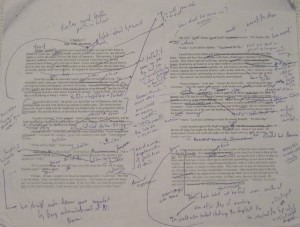I spent most of last weekend refinishing furniture; or, I should say, starting to refinish furniture. My wife instructed me to refinish a buffet and bookshelf to match our new couch, and I envisioned finishing on Saturday morning in time to do some editing and watch some football. But the process, as I learned, is actually much too long (for me, at any rate) to complete in one weekend. I knew that I was in trouble when we went to the neighborhood hardware store, and the helpful clerk kept handing me paintbrushes, sandpaper, and various toxic chemicals until I couldn’t see past the small mountain of supplies in my arms. What, I wondered, have I gotten myself into?
Well, for starters, there was stripping the finish off the wood. To do this, I first painted the furniture with a foul-smelling, viscous (think the slime from Ghostbusters II), bluish liquid that burned to the touch. Being the brilliant person that I am, I first poured this caustic substance into a plastic cup. It ate through the bottom of the cup in seconds and formed a puddle on the floor, in which the rest of the cup proceeded to dissolve. (I would later step in this puddle and find that it also dissolves the rubber soles of sneakers.) And this was just the beginning of the beginning. Next, I scraped off the finish, then sanded down the furniture, twice. At this point, I was finally ready to apply the pre-stain, after which would come the actual stain, and after that, the new finish.
As I spent hours sanding the buffet (no power sander for me), I reflected on the many similarities between the refinishing process and finishing a novel. Before I started writing, I imagined that novelists wrote their novels, typed ‘the end,’ and handed it straight to an editor. In truth, there is a lot more scraping, sanding, and polishing to be done before a novel ever sees the eyes of an editor.
I clearly remember the day in July of 2006 when, sitting under the gilt, neo-Baroque dome of the Library of Congress, I triumphantly wrote the final, magic words for SIEGE: ‘The End.’ It was a joyous moment… for about ten minutes. For an inkling of how I felt, check out this short-film, “Finishing the Novel†(written, directed by, and starring David Wain, and co-starring a young Amanda Peet): http://www.youtube.com/watch?v=LHFEUTvqXR4.
I didn’t throw SIEGE on the fire or trash my computer, like David Wain’s character, but I did have mixed feelings. Was I happy to be done? Yes! But now that I had finished a draft, I realized that I wasn’t really done. I had only finished the beginning. In furniture re-finishing terms, I had just finished painting on toxic-goo and melting my sneakers.
Now, I have a confession to make. I absolutely love editing, as the picture below makes clear:

James Michener once wrote, “I’m not a very good writer, but I’m an excellent rewriter.â€Â Well, I don’t claim to be the next Michener, but I do think I’m a much stronger rewriter than writer. The first time through, I’m just hoping to get the bones of the story down and figure out my characters. The second time, I straighten out the plot and make everything fit together. This is where the hard work regarding the story gets done. It’s not until the third draft that I actually get to work on the writing. I went through four complete drafts of SIEGE before I was ready to show it to an agent. I added scenes, cut chapters, changed characters, and re-wrote the beginning a half-dozen times. The novel shrank from 242,000 words to 230,000 words.
And it kept shrinking from there. After I got an agent (more on that in the upcoming Secret Agent Man), I did three more drafts before showing SIEGE to a publisher. My novel went from 230,000 to 150,000 words. Entire sections hit the cutting floor. The beginning was again re-written. The battle scene that starts the book went from one-hundred pages to five. Did I miss those pages? Yes, but the cuts definitely made the novel better. After I sold the book, I worked with my editor to produce two more drafts, cutting the book down to 137,000 words. I added a few more scenes and took out a couple of extraneous plotlines. Just today, I finished up making changes to the copy-edited manuscript. Over four years after I finished SIEGE, I finally finished SIEGE. Of course, it doesn’t have to take that long: I was learning along the way when I wrote SIEGE. I’m blazing through five drafts of my second novel in one year. But no matter how long it takes, all manuscripts must be re-finished before they’re finished.
But isn’t that what editors are for? Well, no. Editors are there to help you polish your work. They’re not there to do the heavy-lifting of plot and character development. Especially as a first time novelist, if your writing isn’t excellent to begin with, then it will be hard to get a publisher to even take a look at it. The better your manuscript is, the better chance you have of selling it. Don’t wait until you have an editor to make edits. And editing will not only help you sell your novel, it will make it much easier to write. Trying to pin down plot and characters while also writing clean, elegant prose is damned hard. So take it easy on yourself. Get your ideas down first, then you can cut them down to size and polish them up later.
And, on that note, I’ve got to get back to editing my next book (and refinishing the buffet). Come back next week for the exciting story of how I got my agent: Secret Agent Man.
Leave a Reply